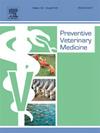澳大利亚新南威尔士州纯种马胎损特征及时空分布
IF 2.4
2区 农林科学
Q1 VETERINARY SCIENCES
引用次数: 0
摘要
尽管近年来在澳大利亚纯种马中出现了疾病综合征,但在行业中没有对胎儿丢失进行正式的监测。本研究旨在描述一个主要纯种马养殖区妊娠45天马妊娠损失的分布特征,以提供原因、预防和监测可行性的见解。方法收集2015年2月至2021年11月间向兽医病理部门提交的574例胎儿丢失的数据。变量包括胎儿丢失日期、胎龄、诊断、马驹体重和母马年龄。诊断分为14类,包括感染性和非感染性原因。时间序列分析用于识别趋势和季节性,空间分析使用Kulldorf时空排列扫描统计量来检测胎儿丢失病例的时空聚类。结果574例病例中,确诊病因467例,感染原因占54% %,非感染原因占46% %。最常见的诊断是脊髓闭塞(19.5% %)和原因不明(18.6% %)。时间序列分析揭示了胎儿丢失的季节性趋势,由于鹦鹉热衣原体胎盘炎的爆发,2016年胎儿丢失达到高峰。这也是确定空间集群的唯一原因。结论在双胞胎和EHV-1病例仍然存在的情况下,正在出现由鼻热梭菌引起的胎盘炎等情况。尽管有这些变化,但妊娠损失的总体可预测时间分布表明,在该地区纯种马妊娠损失监测系统内,有可能早期发现疫情。本文章由计算机程序翻译,如有差异,请以英文原文为准。
Characteristics and spatio-temporal distribution of fetal loss in thoroughbred mares in New South Wales, Australia
Introduction
Despite emerging disease syndromes in Australian Thoroughbred horses in recent years, there is no formal surveillance for fetal loss in the industry. This study aimed to characterise the distribution of equine pregnancy loss > 45 days of gestation in a major Thoroughbred breeding region to provide insights into causes, prevention, and surveillance feasibility.
Methods
Data were collected from 574 fetal loss submissions to veterinary pathology services between February 2015 and November 2021. Variables included date of fetal loss, gestational age, diagnosis, foal weight, and mare age. Diagnoses were grouped into 14 categories, including infectious and non-infectious causes. Time-series analysis was conducted to identify trends and seasonality, while spatial analysis used Kulldorf’s space-time permutation scan statistic to detect spatio-temporal clusters of fetal loss cases.
Results
Of the 574 cases analysed, 467 had a confirmed cause, with infectious agents responsible for 54 % and non-infectious causes for 46 %. The most common diagnoses were cord occlusion (19.5 %) and unknown causes (18.6 %). Time-series analysis revealed seasonal trends in fetal loss, with a peak in 2016 due to a Chlamydia psittaci placentitis outbreak. This was also the only cause for which spatial clusters were identified.
Conclusion
The findings indicate that, while cases of twinning and EHV-1 still exist, conditions such as placentitis due to C. psittaci are emerging. Despite these changes, the overall predictable temporal distribution of pregnancy loss indicates the potential for early outbreak detection within a surveillance system for Thoroughbred pregnancy loss in this region.
求助全文
通过发布文献求助,成功后即可免费获取论文全文。
去求助
来源期刊

Preventive veterinary medicine
农林科学-兽医学
CiteScore
5.60
自引率
7.70%
发文量
184
审稿时长
3 months
期刊介绍:
Preventive Veterinary Medicine is one of the leading international resources for scientific reports on animal health programs and preventive veterinary medicine. The journal follows the guidelines for standardizing and strengthening the reporting of biomedical research which are available from the CONSORT, MOOSE, PRISMA, REFLECT, STARD, and STROBE statements. The journal focuses on:
Epidemiology of health events relevant to domestic and wild animals;
Economic impacts of epidemic and endemic animal and zoonotic diseases;
Latest methods and approaches in veterinary epidemiology;
Disease and infection control or eradication measures;
The "One Health" concept and the relationships between veterinary medicine, human health, animal-production systems, and the environment;
Development of new techniques in surveillance systems and diagnosis;
Evaluation and control of diseases in animal populations.
 求助内容:
求助内容: 应助结果提醒方式:
应助结果提醒方式:


